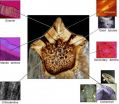(Press-News.org) Take a good look around on your next nature hike. Not only are you experiencing the wonders of the outdoors – you're probably also witnessing evolution in action.
New research from the University of Toronto Mississauga (UTM) on the effect of insects on plant populations has shown that evolution can happen more quickly than was previously assumed, even over a single generation. The study is to be published in the Oct. 5 issue of Science.
"Scientists have long hypothesized that the interaction between plants and insects has led to much of the diversity we see among plants, including crops, but until now we had limited direct experimental evidence," says Marc Johnson, Assistant Professor in the UTM Department of Biology. "This research fills a fundamental gap in our understanding of how natural selection by insects causes evolutionary changes in plants as they adapt, and demonstrates how rapidly these changes can happen in nature."
Johnson and his collaborators from Cornell University, University of Montana and University of Turku in Finland, planted evening primrose, a typically self-fertilizing plant with genetically identical offspring, in two sets of plots. Each plot initially contained 60 plants of 18 different genotypes (plants that contain different sets of mutations).
To test whether insects drive the evolution of plant defenses, one set of plots was kept free of insects with a regular biweekly application of insecticide over the entire study period. The other set of plots received natural levels of insects.
The plots were left to grow without other interference for five years. Each year, Johnson and his collaborators counted the number and types of plants colonizing the plots. They also analyzed the changing frequencies of the different evening primrose genotypes and the traits associated with these genotypes.
Johnson says that evolution, which is simply a change in genotype frequency over time, was observed in all plots after only a single generation. Plant populations began to diverge significantly in response to insect attack in as few as three to four generations. For instance, plants that were not treated with insecticide had increases in the frequencies of genotypes associated with higher levels of toxic chemicals in the fruits, which made them unpalatable to seed predator moths. Plants that flowered later, and thus avoided insect predators, also increased in frequency.
Johnson says the findings also show that evolution might be an important mechanism that causes changes in whole ecosystems. "As these plant populations evolve, their traits change and influence their interactions with insects and other plant species, which in turn may evolve adaptations to cope with those changes," says Johnson. "The abundance and competitiveness of the plant populations is changing. Evolution can change the ecology and the function of organisms and entire ecosystems."
Additional ecological changes occurred in the plots when insects were removed. Competitor plants, such as dandelion, colonized both sets of plots but were more abundant in plots without insects. This in turn reduced the number of evening primrose plants. The dandelion used more resources and also potentially prevented light from reaching the evening primrose seeds, impacting seed germination. According to Johnson, these ecological changes were the result of the suppression of a moth caterpillar that preferred to feed on dandelion.
"What this research shows is that changes in these plant populations were not the result of genetic drift, but directly due to natural selection by insects on plants," says Johnson. "It also demonstrates how rapidly evolutionary change can occur – not over millennia, but over years, and all around us."
INFORMATION:
This research was supported by the Natural Sciences and Engineering Research Council of Canada, the University of Toronto's Connaught Fund and the National Science Foundation.
MEDIA CONTACTS:
Marc Johnson
Department of Biology
University of Toronto at Mississauga
marc.johnson@utoronto.ca
Nicolle Wahl
U of T Mississauga Communications
905-569-4656
nicolle.wahl@utoronto.ca
Everyday evolution
Insects a prime driver in plant evolution and diversity, says U of T Mississauga research
2012-10-05
ELSE PRESS RELEASES FROM THIS DATE:
Abortion rates plummet with free birth control
2012-10-05
Providing birth control to women at no cost substantially reduced unplanned pregnancies and cut abortion rates by 62 percent to 78 percent over the national rate, a new study shows.
The research, by investigators at Washington University School of Medicine in St. Louis, appears online Oct. 4 in Obstetrics & Gynecology.
Among a range of birth control methods offered in the study, most women chose long-acting methods like intrauterine devices (IUDs) or implants, which have lower failure rates than commonly used birth control pills. In the United States, IUDs and implants ...
How ketamine defeats chronic depression
2012-10-05
Many chronically depressed and treatment-resistant patients experience immediate relief from symptoms after taking small amounts of the drug ketamine. For a decade, scientists have been trying to explain the observation first made at Yale University.
Today, current evidence suggests that the pediatric anesthetic helps regenerate synaptic connections between brain cells damaged by stress and depression, according to a review of scientific research written by Yale School of Medicine researchers and published in the Oct. 5 issue of the journal Science.
Ketamine works on ...
UCLA astronomers discover star racing around black hole at center of our galaxy
2012-10-05
UCLA astronomers report the discovery of a remarkable star that orbits the enormous black hole at the center of our Milky Way galaxy in a blistering 11-and-a-half years — the shortest known orbit of any star near this black hole.
The star, known as S0-102, may help astronomers discover whether Albert Einstein was right in his fundamental prediction of how black holes warp space and time, said research co-author Andrea Ghez, leader of the discovery team and a UCLA professor of physics and astronomy who holds the Lauren B. Leichtman and Arthur E. Levine Chair in Astrophysics. ...
Climate sceptics more prominent in UK and US media
2012-10-05
Climate sceptics are being given a more prominent, and sometimes uncontested, voice in UK and US newspapers in contrast to other countries around the world, new research suggests.
The findings have been published today, 5 October, in IOP Publishing's journal Environmental Research Letters, as part of a study looking at how climate scepticism manifested itself in the print media of the US, UK, Brazil, China, India and France during a 3-month period which included 'Climategate' in 2009/10 and a second period which covered the IPCC's Fourth Assessment Report in 2007.
In ...
Maths sheds light on what delays in getting pregnant means for prospects of having a baby
2012-10-05
A new mathematical method can help to predict a couple's chances of becoming pregnant, according to how long they have been trying.
The model may also shed light on how long they should wait before seeking medical help.
For example, the researchers have found that, if the woman is aged 35, after just six months of trying, her chance of getting pregnant in the next cycle is then less than 10 per cent.
The analysis, developed at Warwick Medical School at the University of Warwick and the London School of Economics, uses the number of menstrual cycles over which the ...
Plants adapt their defenses to the local pest community
2012-10-05
Herbivorous insects, such as aphids, damage plants and can substantially reduce yields in agricultural settings; however, they can play a major role in maintaining genetic diversity. Ecologists Tobias Züst and Lindsay Turnbull from the University of Zurich together with colleagues from California and Great Britain demonstrated the importance of variation in herbivore communities using the model plant, Arabidopsis thaliana, also known as wall cress. According to Züst, the work is one of the first experimental confirmations of a forty-year-old theory that herbivorous insects ...
Duck-bill dinosaurs had plant-pulverizing teeth more advanced than horses
2012-10-05
A team of paleontologists and engineers has found that duck-billed dinosaurs had an amazing capacity to chew tough and abrasive plants with grinding teeth more complex than those of cows, horses, and other well-known modern grazers. Their study, which is published today in the journal Science, is the first to recover material properties from fossilized teeth.
Duck-bill dinosaurs, also known as hadrosaurids, were the dominant plant-eaters in what are now Europe, North America, and Asia during the Late Cretaceous about 85 million years ago. With broad jaws bearing as many ...
Medication use higher among overweight, obese kids
2012-10-05
(Edmonton) Overweight children are far more likely to take prescription medications than children of a normal weight—a trend that adds to already higher health-care costs for treating childhood obesity, according to new research from the University of Alberta.
Researchers from the School of Public Health analyzed the medication use of more than 2,000 Canadian children through the 2007 to 2009 Canadian Health Measures Survey. They found that overweight and obese kids aged 12 to 19 years were 59 per cent more likely than their normal-weight peers to take prescription medication.
Co-author ...
TMT will take discoveries of stars orbiting the Milky Way's monster black hole to the next level
2012-10-05
Researchers have discovered a star that whips around the giant black hole at the center of our galaxy in record time, completing an orbit every 11.5 years. The finding, appearing today in the journal Science, points ahead to groundbreaking experiments involving Einstein's general theory of relativity. Those tests will be fully enabled by the Thirty Meter Telescope (TMT), slated to begin observations next decade.
The record-setting star, called S0-102, was detected with the twin 10-meter telescopes at the W.M. Keck Observatory in Hawaii. For the past 17 years, the telescopes ...
Story tips from the Department of Energy's Oak Ridge National Laboratory, October 2012
2012-10-05
ELECTRICITY-- Spotlight on outages . . .
When a storm knocks out power, among the first questions to be answered are how many people are affected and when electricity will be restored. Oak Ridge National Laboratory's Energy Awareness and Resiliency Standardized Services application, or EARSS, uses publicly available data and can help by showing grid status in real time. The goal is to enhance situational awareness for the emergency response community, according to EARSS co-developer Steve Fernandez of ORNL's Computational Sciences and Engineering Division. "Working from ...
LAST 30 PRESS RELEASES:
Making lighter work of calculating fluid and heat flow
Normalizing blood sugar can halve heart attack risk
Lowering blood sugar cuts heart attack risk in people with prediabetes
Study links genetic variants to risk of blinding eye disease in premature infants
Non-opioid ‘pain sponge’ therapy halts cartilage degeneration and relieves chronic pain
AI can pick up cultural values by mimicking how kids learn
China’s ecological redlines offer fast track to 30 x 30 global conservation goal
Invisible indoor threats: emerging household contaminants and their growing risks to human health
Adding antibody treatment to chemo boosts outcomes for children with rare cancer
Germline pathogenic variants among women without a history of breast cancer
Tanning beds triple melanoma risk, potentially causing broad DNA damage
Unique bond identified as key to viral infection speed
Indoor tanning makes youthful skin much older on a genetic level
Mouse model sheds new light on the causes and potential solutions to human GI problems linked to muscular dystrophy
The Journal of Nuclear Medicine ahead-of-print tip sheet: December 12, 2025
Smarter tools for peering into the microscopic world
Applications open for funding to conduct research in the Kinsey Institute archives
Global measure underestimates the severity of food insecurity
Child survivors of critical illness are missing out on timely follow up care
Risk-based vs annual breast cancer screening / the WISDOM randomized clinical trial
University of Toronto launches Electric Vehicle Innovation Ontario to accelerate advanced EV technologies and build Canada’s innovation advantage
Early relapse predicts poor outcomes in aggressive blood cancer
American College of Lifestyle Medicine applauds two CMS models aligned with lifestyle medicine practice and reimbursement
Clinical trial finds cannabis use not a barrier to quitting nicotine vaping
Supplemental nutrition assistance program policies and food insecurity
Switching immune cells to “night mode” could limit damage after a heart attack, study suggests
URI-based Global RIghts Project report spotlights continued troubling trends in worldwide inhumane treatment
Neutrophils are less aggressive at night, explaining why nighttime heart attacks cause less damage than daytime events
Menopausal hormone therapy may not pose breast cancer risk for women with BRCA mutations
Mobile health tool may improve quality of life for adolescent and young adult breast cancer survivors
[Press-News.org] Everyday evolutionInsects a prime driver in plant evolution and diversity, says U of T Mississauga research




